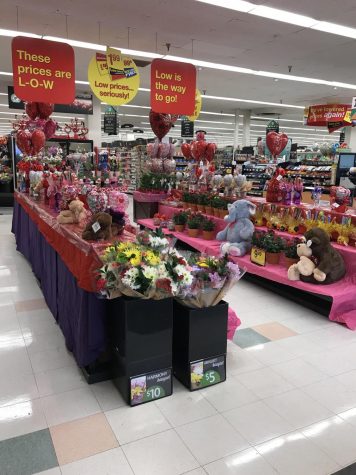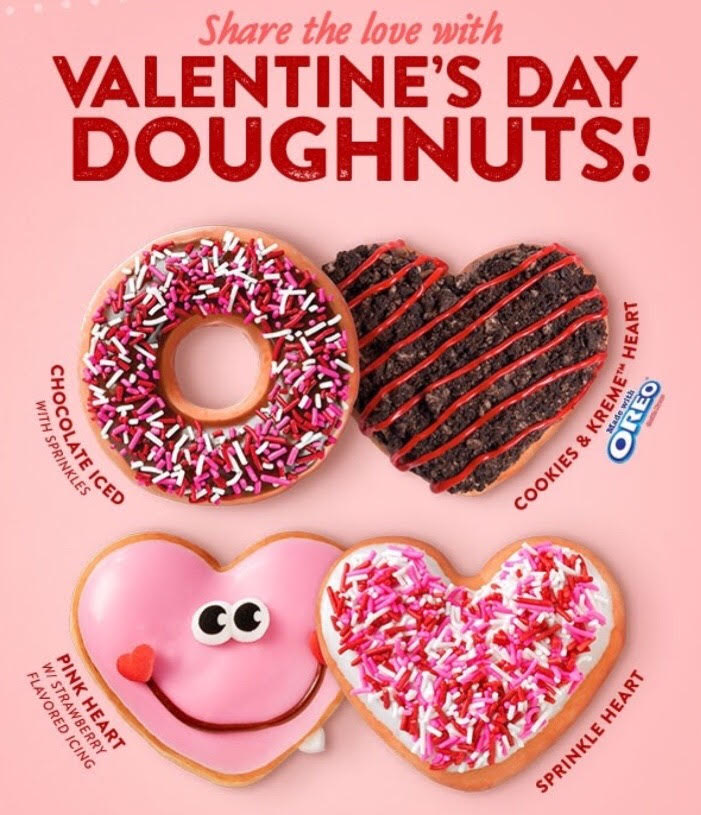February 14
February 13, 2018
When you Google Valentine’s Day, what pops up? The date, pictures of hearts and flowers, the occasional news story on what celebrities are doing, and finally ads for stores like Victoria Secret. As the new year starts, all that’s advertised is working out and then a reward for getting into shape: displaying your body in barely any clothes. Valentine’s Day has become so sexual, the pressure is on whether you’re single, in a new or old relationship, or even married.
The angle for this story is why February 14 is so sexualized. The initial Google search proved the point, the first four results were all about intercourse, followed by two articles by a church organization. Finally, there were articles by a psychology website and a news site.
According to The Telegraph, the history of St. Valentine’s Day dates back to a Pre-Christian era. Back when there was nudity and whippings, today it’s commercialized and drives sales of chocolate, flowers, and jewelry.
A Brief History
| 197: A Christian known as Valentine of Terni is martyred in the reign of Emperor Aurelian. According to legend, he died on 14 February, but that is likely a later embellishment. | ||
| 289: Another Christian, Valentine of Rome, is martyred, this time under Emperor Claudius. Like his earlier namesake, Valentine of Rome is supposed to have died on 14 February, but – again – this is implausible. | ||
| 496: The then Pope, Gelasius, declared 14 February to be St Valentine’s Day, a Christian feast day. This is likely to have been an if-you-can’t-beat-them-join-them approach to the still-popular pagan festival of Lupercalia. | ||
| 1382: Geoffrey Chaucer writes his Parlement of Foules which is widely taken to be the first linking of St Valentine’s Day to romantic love. Celebrating the engagement of Richard II of England and Anne of Bohemia, he wrote: “For this was on St. Valentine’s Day/ When every fowl cometh there to choose his mate.” | ||
| 1400: On St Valentine’s Day a court is opened in Paris, the High Court of Love, dealing with affairs of the heart: marriage contracts, divorces, infidelity, and beaten spouses. A few years later, Charles, the Duke of Orleans writes the first recorded Valentine’s note to his beloved, while imprisoned in the Tower of London following capture at the Battle of Agincourt in 1415. | ||
| 1601: St Valentine’s Day has entered the popular consciousness to the extent that one William Shakespeare mentions it in Ophelia’s lament in Hamlet: “To-morrow is Saint Valentine’s day,/All in the morning betime,/And I a maid at your window,/To be your Valentine.” | ||
| Mid-18th century: The passing of love-notes becomes popular in England, a precursor to the St Valentine’s Day card as we know it today. Early ones are made of lace and paper. | ||
| 1797, the The Young Man’s Valentine Writer is published, suggesting appropriate rhymes and messages, and as postal services became more affordable, the anonymous St Valentine’s Day card became possible. By the early 19th century, they become so popular that factories start to mass-produce them. | ||
| 1847: Following the English tradition, Esther Howland of Worcester, Massachusetts, starts producing cards – using the newly available and much cheaper paper lace – in the United States. | ||
| 1913: “The beginning of the end” for St Valentine’s Day as a genuinely romantic event, and the start of its reinvention of a savagely imposed regime of sugar-coated tweeness designed to chisel spare cash out of lovers and would-be lovers worldwide: Hallmark Cards produce their first Valentine. Now the date is the flagship “Hallmark Holiday” – together with Mothers’ Day, Fathers’ Day and so on, a series of celebrations notable more for the need to spend money than any heartfelt sentiment. | ||
| 1929: The St Valentine’s Day Massacre. A savage and bloody event in itself – five Chicago gangsters lined up and murdered with machine guns, apparently at the behest of Al Capone – but at least it’s a break from the unending stream of saccharine that the history of St Valentine’s Day otherwise entails, and so is welcome here. | ||
| 1980s: The commercialisation continues: noting the sales effect of the holiday on chocolate, flowers and cards, the diamond industry gets involved, promoting St Valentine’s Day as a time for giving jewellery. The “tradition” takes off. |
Tradition can be unsatisfying. The stress of finding the perfect gift, the perfect flowers, or the brightest jewel isn’t sold in all the Hallmark ads. Shane Company is taking over radio stations, but I just want to listen to music, not the location of your store (which by the way, I already had memorized). The psychology behind this day is everything but pleasing. Turns out Valentine’s Day is ruining relationships, according to PsychologyToday.com. Multiple studies, including one tracking Facebook breakup statuses, have shown that couples are more likely to break up in the weeks before and after Valentine’s Day. So, why does a holiday meant to celebrate relationships result in more break-ups?
Research Points
| Expectations | For many, Valentine’s Day comes with a host of expectations including gifts, special dinners, and romantic locales. Yet setting expectations so high can set us up for disappointment when reality doesn’t match up to these unrealistic hopes. One study found that couples who enter relationships with positive expectations are more likely to face later disappointment and relationship dysfunction than couples who enter with more realistic expectations. |
| Comparisons | Valentine’s Day plans like dinners, concerts, or events are usually more public – talked about in conversation and even shared on social media. Seeing and hearing about others’ sometimes embellished or idealized accounts of their celebrations makes it difficult to avoid comparing them to our own. These comparisons can lead to dissatisfaction about our own way of celebrating, even if it was perfectly enjoyable and satisfying in the moment. |
| Magnification | For relationships that may already be shaky, Valentine’s Day might highlight and even exacerbate existing issues. Valentine’s Day expectations of not just a “perfect” night, but also a “perfect” relationship may make any problems seem worse than they are, causing increased dissatisfaction. Or, the pressure may just intensify negative feelings in an already dysfunctional relationship. |
psychologytoday.com
There’s another huge problem with Valentine’s day, according to Psychology Today, and that’s bottling up all of our love for one special day. By containing our emotions we aren’t allowed to practice the preferred gestures everyday, like gratitude and affirmations, that make relationships thrive. More often than not, partners may use extravagant dinners and gifts as band-aids for chronic relationship issues.
The importance of this daily attention to relationships and significant others is supported by research from the couples psychologists, John and Julie Gottman. In a famous experiment, the Gottmans observed interactions between 130 newlyweds during a day at a bed and breakfast retreat. They saw that throughout the day, one or both partners would try to make connections with the other by bidding for their loved one’s attention. In some cases the wife or husband would “turn toward” their significant other and in other cases he or she “turn away.” Those who chose to pay attention to and engage with their significant other were more than two times as likely to be together six years later. Through observing these interactions,The Gottmans can predict with up to 94 percent certainty whether couples will stay together or break up in the future.
What’s important isn’t an annual celebration of your love, but rather a more constant attention to and engagement with your partner. Sure, juggling work obligations, family demands, and social commitments can make it difficult. All of this information provided isn’t to say that we shouldn’t celebrate Valentine’s Day at all, but a reminder that we all need to take it a little less seriously.
Tips to Prioritize Your Relationship Throughout the Year
| Date Night
Instead of promising to spend more time together, put a time on the calendar for a special date or even just a night in together. Scheduling a date night will make it more likely that you will follow through and can also make that time together feel more intentional and therefore special. |
| Try New Experiences
Breaking routine and trying new things releases oxytocin in the brain. This natural boost can also help make a relationship feel fresh and new. |
| Help
A way to show that you love and care for your partner, especially when schedules get busy is to help your partner. Make them dinner on a busy day, put the kids to bed, or take care of some chores that have piled up. |
psychologytoday.com
In the end, size doesn’t matter. Look for the seemingly insignificant moments that’s what make a relationship work best, according to Psychology Today. Gratitude, affection and hard work every day of the week makes a relationship last—not a box of chocolates once a year.
Let’s be real now, we’re teenagers. Contrary to all the stereotypes, not all of us are in relationships with the star football player or leading drum major or the cute nerd in the front of class. A lot of us spend Valentine’s Day alone, and even if we are in a relationship we’re the most miserable group, according to Time magazine.
According to new data compiled by social-media platform We Heart It, the vast majority of 21,000 responses (over 98%) were from teenage girls, and they didn’t have a lot of love for the holiday. Only 13% of teenagers under 15 think Valentine’s Day is “painful,” while 22% say it’s “overrated,” and 24% think it’s irrelevant. Teenagers are also the least likely age group to send Valentines, with over 53% saying they’re not sending any at all (compared with 41% of respondents over 25).
Apparently, posting giant teddy bears and chocolates roses aren’t great either. Yes, our social savvy generation have a very different attitudes about social media on Valentine’s Day — and it’s giving new meaning to the phrase “love hurts.”
Young teens thoughts about social media’s need to the Valentine’s Day experience
| 10% | Thought that Valentine’s Day was “very important” to Instagram and Tweet about their gifts |
| 21% | Thought social media was “extremely important” on Valentine’s Day |
| 64% | Thought social media was “somewhat” important. |
Time Magazine
Valentines Day Reactions on Social Media
| 31% | Said social media made them feel stressed |
| 34% | Said social media made them jealous |
| 36% | Thought social media made Valentine’s Day more fun |
Time Magazine
Valentine’s Day is supposed to become better with age according to Time magazine. For the time being, if you happen to be in a relationship it is best to spread the love out. To the singles of Valentine’s Day, enjoy yourself and maybe avoid social media for the day, or week for that matter. As far as St. Valentine’s Day goes, it depends on your feelings about it. There’s no need to completely boycott the day itself or to spend hundreds; at the end of the day, the date is just Wednesday, February 14, 2018.


